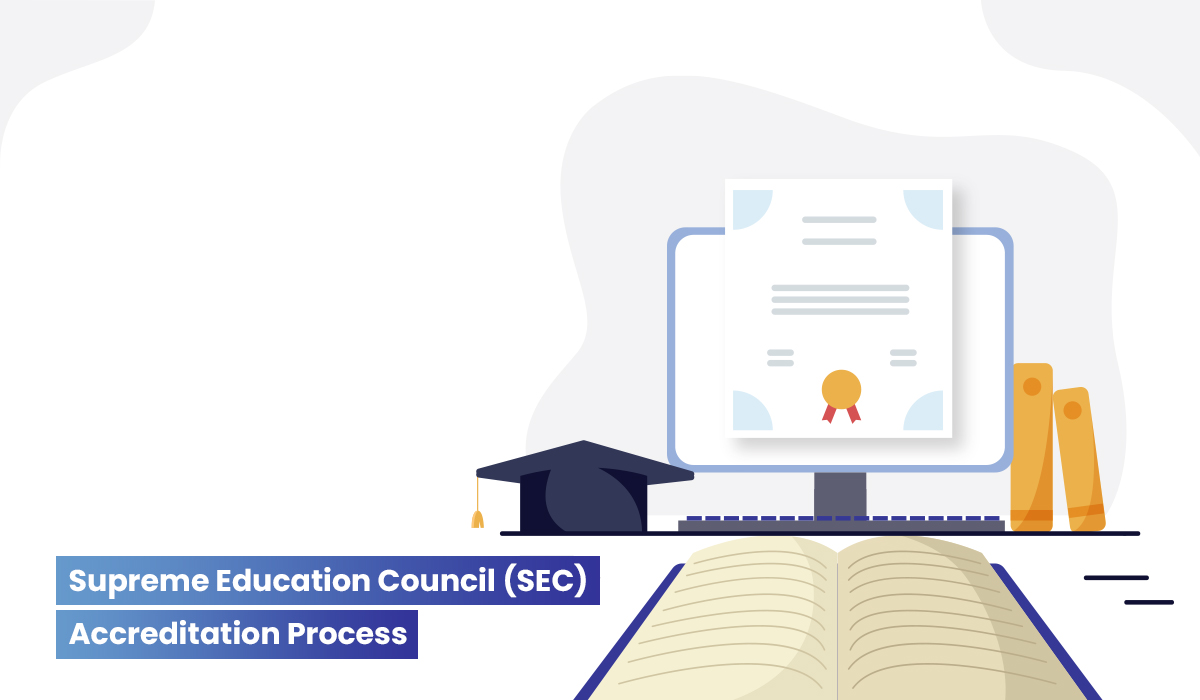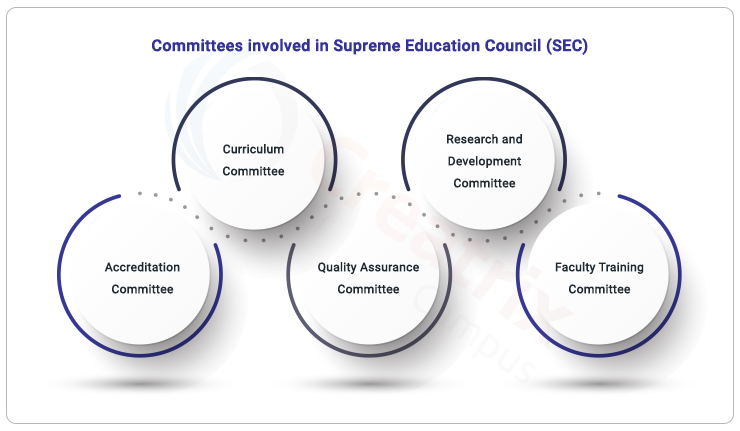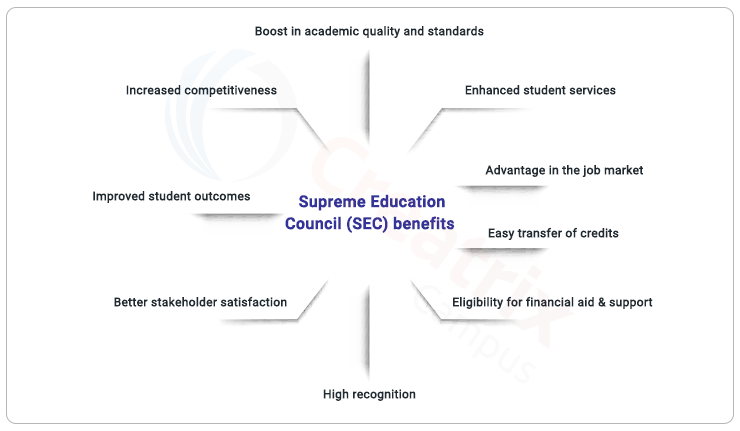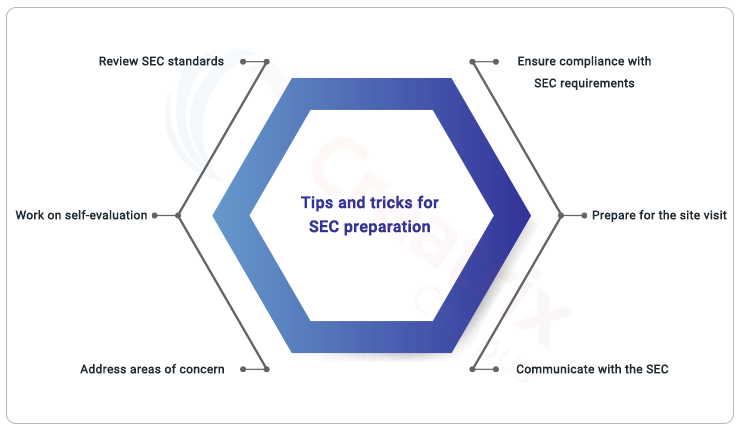An Overview of the Accreditation Process with the Supreme Education Council (SEC) Qatar

What everyone knows of Qatar’s Supreme Education Council (SEC) is that it is a governing body that is responsible for overseeing and directing the higher education sector, establishing policies, setting standards, and allocating resources to ensure that education in the country is of high quality and accessible to all in the country.
But there’s much more to it. We intend to provide a comprehensive overview of the SEC (Supreme Education Council) accreditation process, including the steps involved, benefits, preparation, and considerations in this post. Our purpose is to provide institutions with valuable information and insights to help them navigate the SEC accreditation process effectively and achieve a successful outcome.
Background - The higher education in Qatar
Qatar’s higher education sector, roughly around 2002 was still in its early stages of development. While there were a few universities and colleges in operation, the education system was largely underfunded and lacked the infrastructure, resources, and policies necessary to support a comprehensive and high-quality education system.
Despite these challenges, a small but dedicated group of educators, administrators, and students worked hard to provide educational opportunities and promote academic excellence. Over time, the higher education sector in Qatar grew and matured, and new institutions were established to meet the growing demand for education.
However, the lack of a central authority to oversee and direct the development of higher education was a major limitation, and progress was slow. It wasn't until the establishment of the Supreme Education Council for certification that the higher education sector in Qatar began to experience significant growth and development.
The new educational reform - Supreme Education Council (SEC)
The establishment of the Supreme Education Council (SEC) marked a turning point for higher education in Qatar, as the council provided the necessary resources, policies, and support to promote a comprehensive and high-quality education system.
It was born out of Qatar's 2030 Vision, which was established by a plan to educate highly productive, skilled Qataris to fill job openings in the best industry sectors and the public sector. This tactic, referred to as "Qatarization," aims to increase the proportion of Qatari nationals in senior roles currently held by foreigners in business, important industries/sectors, and government agencies.
The SEC's efforts have helped to create a world-class education system that is accessible, and inclusive, and prepares students for successful careers and active citizenship.
The SEC has implemented several initiatives to improve the quality of higher education in Qatar. These include the establishment of new universities and colleges, the creation of research centers and institutes, and the introduction of new programs and courses. The council has also worked to attract international faculty and students to Qatar and to encourage collaboration between local and international universities.
In addition, the SEC has been instrumental in promoting academic excellence, fostering research and innovation, and providing students with a range of educational opportunities. Through its efforts, the higher education sector in Qatar has grown and matured and is now widely recognized as one of the best in the region.
What is Supreme Education Council (SEC) and what is its role?
The Supreme Education Council (SEC) is the primary governing body responsible for the education sector in Qatar. The SEC is responsible for developing and implementing policies, regulations, and programs related to education in Qatar and overseeing the operation of public and private schools, vocational training institutions, and higher education institutions.
The SEC plays a critical role in ensuring the quality of education in Qatar and supporting the development of the education sector.

Some of the key responsibilities of the SEC include:
- Developing and implementing policies, regulations, and programs related to education
- Overseeing the operation of public and private schools, vocational training institutions, and higher education institutions
- Promoting research and innovation
- Providing training and development opportunities for faculty
- Supporting the development of students and faculty in HEI
- Ensuring the quality of education in Qatar and promoting continuous improvement
- Working with educational institutions and other stakeholders to support the development of the education
The Supreme Education Council (SEC) committee

The Supreme Education Council (SEC) for certification has a number of committees that are responsible for various aspects of its work. They work closely with the various departments within the SEC and with educational institutions and other stakeholders to achieve the goals and objectives of the SEC.
The committees play an important role in ensuring that the SEC is able to effectively carry out its work and support the development of the education sector in Qatar. These committees may include:
Key standards for licensing and accreditation from SEC

The ministry of Supreme Education Council Qatar (SEC) considers several key factors during the accreditation process, which are used to determine an institution's compliance with SEC standards. These include:
Note: This list is not exhaustive and the SEC may consider other factors in its accreditation process as well.
Steps involved in the Supreme Education Council (SEC) accreditation process

The Supreme Education Council (SEC) accreditation process typically involves the following steps:
Note: The SEC accreditation process may vary and the above steps may not be in the exact same order as described above.
Timeframe for the accreditation process
The timeframe for the Supreme Education Council (SEC) accreditation process can vary depending on several factors, such as the size, complexity, and responsiveness of the institution to any concerns identified during the accreditation process. On average, the accreditation process can take anywhere from several months to over a year to complete.
It's important to note that accreditation is an ongoing process, and institutions are typically re-evaluated on a regular basis, usually every five to seven years, to ensure they maintain compliance with SEC standards.
Institutions may also be subject to interim evaluations, reviews, and site visits between regular accreditation cycles.
Benefits of SEC Accreditation

The Supreme Education Council (SEC) accreditation provides several benefits for institutions and students, including:
- Improved academic quality and standards.
- Increased competitiveness in the job market.
- Improved student outcomes and satisfaction.
- Better reputation and credibility of the institution as a result of meeting high standards of quality.
- Enhanced student services with adequate support services for students including student advising, career services, health services, and a lot more.
- SEC-accredited institutions will have an advantage in the job market, as employers often view SEC accreditation as a sign of high-quality education.
- Students at SEC-accredited institutions may be eligible for financial aid and other forms of support, which can help make higher education more accessible.
- The SEC accreditation ensures that an institution's degrees are recognized by other accredited institutions, both domestically and internationally, making it easier for students to transfer credits or continue their education elsewhere.
Tips for HEIs preparing for the SEC Accreditation Process

Preparation is key to successfully navigating the ministry of Supreme Education Council Qatar (SEC) accreditation process. Institutions preparing for accreditation should follow these steps:
Review SEC standards: Familiarize yourself with the SEC standards and requirements for accreditation. This will help you identify any areas of your institution that may need improvement before the accreditation process begins.
Conduct self-evaluation: Conduct a thorough self-evaluation of your institution, including a review of your facilities, staff, curriculum, and student services. This will help you identify areas of strength and areas that need improvement.
Work on Self-Evaluation Report (SER) beforehand: Based on your self-evaluation, prepare a comprehensive self-evaluation report (SER) that details your institution's strengths, weaknesses, and plans for improvement. The SER should include relevant data and evidence to support your claims.
Address areas of concern: Address any areas of concern identified during the self-evaluation process. This may involve making improvements to facilities, strengthening your staff, or revising your curriculum.
Ensure compliance with SEC requirements: Ensure that your institution is fully compliant with all SEC requirements, including those related to facilities, staff, curriculum, and student services.
Prepare for the site visit: Prepare for the site visit by the SEC-appointed evaluators by gathering relevant information and making any necessary preparations.
Communicate with the SEC: Maintain open communication with the SEC throughout the accreditation process and respond promptly to any requests for information.
Challenges institutions face during the SEC Accreditation Process

The Supreme Education Council (SEC) accreditation process can be complex and challenging, and institutions may face several considerations and obstacles during the process.
Some of the common challenges and considerations include:
- Preparing for the accreditation process by collecting and organizing data and information, conducting self-assessments, and addressing any areas of concern before the accreditation team arrives can be challenging.
- Ensuring compliance with SEC standards and guidelines. These standards cover a wide range of areas, including academic programs, student services, resource management, and more. Institutions must be able to provide evidence of their compliance with these standards.
- Addressing areas of concern during the accreditation process, by demonstrating that they have taken steps to improve. This can be a challenging process, particularly if the institution is not well prepared or has significant areas of weakness.
- Collaborating with stakeholders, including students, faculty, and staff can get tough. Institutions must work closely with these groups to gather information and feedback and to address any areas of concern.
- Institutions must allocate sufficient resources to prepare for the accreditation process and address any areas of concern. This includes staffing, financial resources, and other resources required to meet the standards and criteria established by the SEC.
- Conducting a thorough and honest self-evaluation can be difficult.
- Addressing potential weaknesses or gaps in academic programs.
- Managing resources and timelines effectively can become tough.
- Preparing for the site visit.
- SEC process can be resource-intensive, requiring significant time, effort, and financial resources. Institutions that are understaffed can find it difficult to navigate the process.
- Maintaining open and effective communication with the SEC committee throughout the accreditation process can get tough.
- The longer time frame Institutions must be prepared for the long-term commitment involved in the process. The continuous improvement process with complete data on student outcomes over the years can be challenging to track manually.
The SEC accreditation process is an important part of the quality assurance system, and institutions must prepare thoroughly and demonstrate their compliance with established standards.
The accreditation process may pose challenges, including preparing for the process, meeting standards, addressing areas of concern, collaborating with stakeholders, and managing resources.
Creatrix Accreditation management software can help automate the end-to-end accreditation process so you and your team can work towards the greater vision of achieving institutional excellence and student success. Contact our team for more information.
Overall, the Supreme Education Council plays a critical role in ensuring the quality of education in Qatar and supporting the development of the education sector. By working closely with educational institutions and other stakeholders, the SEC is helping to build a strong and sustainable education system that will benefit students, faculty, and the wider community for years to come.
Final Thoughts
Creatrix Campus can automate the accreditation process with the Supreme Education Council (SEC) in Qatar by streamlining and simplifying many of the manual tasks involved. For example, our product can automate the tracking and reporting of accreditation-related activities, ensuring that all deadlines are met and all relevant information is easily accessible in one centralized location.
Additionally, Creatrix Accreditation Management System provides real-time updates on the status of the accreditation process, enabling organizations to make informed decisions and respond quickly to any changes or requirements. By automating the accreditation process, organizations can save time, reduce the risk of errors, and focus on the core activities that drive their success.



